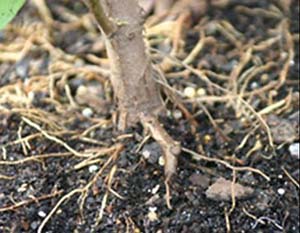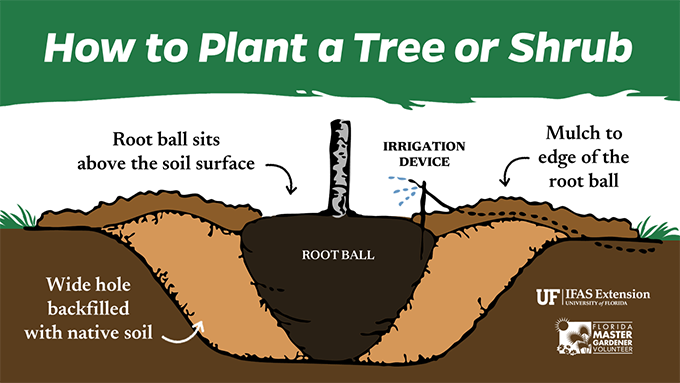Planting and Establishing Shrubs
How you plant and initially care for a shrub can make all the difference to its long-term health. When picking and installing a shrub, keep the following in mind.

Shrubs in this landscape are grouped and spaced for their mature size.
Before you Plant
Right plant, right place. Make sure you've got the right shrub for your site. Consider its mature size. Many of the plants that are labeled "large shrubs" are also considered "small trees." Look up the mature size of your species before you plant it and give it space to grow.
Check the ideal soil type, soil pH, water, and light needs of your shrub species, too. If the site you had in mind doesn't match your shrub's needs, don't plant! Instead, choose a species that can thrive in existing site conditions or choose another part of your landscape. Feel free to call your county Extension office for help finding the right shrub for your site.
Placement matters. Depending on their mature size, shrubs placed in the right spot can naturally cool or insulate your home. Don't plant shrubs too close to the house, though. Planting too close will reduce airflow and leave your shrubs vulnerable to fungal diseases. It makes it hard to perform maintenance on the home as well. Keep the center of the plant more than 2.5 feet from the foundation.
Plant in groups. Groups of multiple shrubs will give your landscape design a unified and cohesive feel. Denser plantings are the preferred shelter of most wildlife species, too. Individual plants in a group should touch when they reach their mature size. Adjacent groups of different shrubs should overlap and connect with one another.
Plan ahead to establish. It will take about 5-7 months for a plant to become established in the new site. This is true of both native and non-native species. Until the shrub expands its root system and adjusts to the new site, it will need regular irrigation. The worst time to plant is when the weather is both hot and dry. Some areas of Florida have watering restrictions, too. If you aren't sure you will be able to water regularly, consider planting at the beginning of your local rainy season.
How to Plant Shrubs
If you're renovating your landscape, installing shrubs and other plants should be one of your final steps. Install walkways, irrigation systems, or patios first. Once you are ready to plant, follow these steps.
Call 811 before you dig. It's fast, easy, and free. Your utility company will come out in a matter of days and mark underground wires and pipes for you. Trust us; it's less hassle than hitting a telephone line or sewage pipe.
Break up compacted soil and amend. If people walked or parked on the site, till the top 8-12 inches of soil in the area. This is also a good time to add compost or other organic soil amendments to the entire area. They'll improve the soil of the entire planting and help shrubs establish.
Dig a wide, shallow hole. It should be at least one-and-a-half times wider than the root ball. It is also important that the hole is one or two inches shallower than the root ball.
Most people plant shrubs too deeply. The point on a plant where the highest root joins the trunk is called the "flare." The flare of a shrub or tree should always be above the surface of the landscape soil. By digging a shallow hole you can be sure the flare will be above the soil surface.

The root flare should be above the soil surface.
UF/IFAS, Edward Gilman.
Loosen the root ball. Generally this is only done when planting trees, but if a shrub is very root-bound it may be beneficial. Loosening the root ball encourages roots to quickly grow into the landscape soil and makes the shrub sturdier in winds. You can do this by making multiple slices around the edge or loosening the perimeter by hand.
Slide the shrub into the planting hole and position it carefully. Fill the soil back around the sides of the root ball, but don't put any soil on top of it. If the flare is not above the soil surface, remove the shrub carefully. Add soil to the bottom of the hole before sliding the shrub in once again.
Contrary to popular belief, adding compost to the planting hole is not a good idea. In Florida's sandy soils and heavy rains, compost breaks down too quickly. The resulting air pockets can leave you with a dried out or sunken shrub. Backfilling the hole with the native soil is a safer option. If you're concerned about the soil quality, amend the entire bed before you plant. You can also top-dress with a thin layer of compost before you mulch.
Add plenty of water to the root ball and planting hole. Make sure the root ball and surrounding soil are very wet. Add more soil around the root ball if the soil sinks after watering.
Add mulch around the plant, but not on top of the root ball. Make sure that mulch is pulled at least 2 inches away from the base of all shrubs. If mulch traps moisture too close to the woody stems, disease often follows.
Water shrubs frequently to help them establish. Light, frequent applications are more efficient and effective than applying large volumes less frequently. And when you water, apply water directly to the root ball and before 10 a.m. whenever possible. Three-gallon shrubs can be established north of Orlando with as little as one gallon of irrigation water applied every eight days. South of Orlando, apply a gallon of water every four days. Even more frequent watering may improve the plant's performance but is not necessary.
Your area may have local water use restrictions. In this case it may be best to plant shrubs at the beginning of the rainy season. Florida's regular rains will do the watering for you.

After Establishment
A shrub is established when new roots have grown into the surrounding soil and it no longer needs regular irrigation to survive. This generally takes about 20 to 28 weeks from the planting date. Most native and Florida-Friendly shrubs can survive and grow with little to no irrigation from this point onward. Once your shrub is established, we recommend waiting for signs of wilting before you irrigate, keeping local water restrictions in mind.
For more information on planting trees and shrubs, contact your county Extension office.

